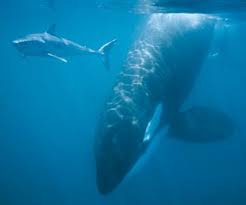Normally, a baby is born in a hospital. That is common knowledge. You have a baby, you go to the hospital to give birth. Hundreds of species all over the world have regular birthing grounds that they travel to at least once a year to give birth to their new offspring. But Great White Sharks aren’t like other species, if you haven’t already noticed. And I am not just referring to their size, strength, or natural beauty. I’m talking about the fact that to this day, no one knows where Great Whites give birth to their young.
 Somewhere in the deep blue sea, Great Whites travel and give birth to their young. It is not even certain if they all travel to the same spot, give birth in groups or individually, or give birth at the same time each year. Despite all of the scientific research performed on Great Whites all over the world, their birthing rituals are a complete mystery! However, there is some information that is known. According to Unreal Dive (an infamous South African
Somewhere in the deep blue sea, Great Whites travel and give birth to their young. It is not even certain if they all travel to the same spot, give birth in groups or individually, or give birth at the same time each year. Despite all of the scientific research performed on Great Whites all over the world, their birthing rituals are a complete mystery! However, there is some information that is known. According to Unreal Dive (an infamous South African
 diving tour that is very knowledgable in Great White Sharks),
diving tour that is very knowledgable in Great White Sharks),
“Little is known about great white shark behaviour in the way of mating habits. Birth has never been observed, but pregnant females havebeen examined. Great white sharks are ovoviviparous (eggs develop and hatch in the uterus, and continue to develop until birth)”
With these facts that scientists have, and the great amount of information acquired with each catch and release mission across the 7 seas, an end to this mystery seems so close, yet so very far.
However, May of 2011 scientists caught and released the biggest male Great White caught on record. Female Great Whites can grow up to 25 ft long. There have even been bite marks found on whale carcasses that measure up to 27 ft! But aside from measuring bite marks and determining sharks of such massive size, 17.9 ft. is the largest male shark caught to date! (Obviously the scientists aren’t including Bruce from Jaws who lives in the “ocean” next to the Universal Studios tour.) For me, thats over 3 times my size and completely unfathomable and unbelievable. And this monstrous creature not only breaks records, but also can help assist in solving the birthing mystery of our Great White friends.
The Great White that was caught and released in the article was caught in the waters off of the Guadalupe Islands of the coast of Mexico. Although this is a very popular spot for Great White Sharks to wander during the fall and winter seasons when the water is very cold, it is rather unlikely that one would find a Great White swimming in this area during the warmer months of March through July, when the shark was found. Because of this unlikely find, the specialists who found the shark think that it might be located there because it is traveling there to give birth, or recently gave birth. Scientists have assumed that
“…recent research suggests that Pacific great whites gather in specific spots near the coasts—including the Guadalupe Island site—and then travel to a “cafe” in the middle of the ocean to feed. The animals often return to the same aggregation sites after feeding.”
If the sharks are coming and going in a predictable pattern, then hopefully more information can soon be found about where exactly the birthing process takes place. Can you imagine if they actually filmed and documented a Great White laying its egg?! That would lead to such a better understanding of the species. National Geographic believes that tagging the sharks in this area would not only lead to the end of a baffling shark mystery, but may also help scientists track and protect the endangered species from fisherman and hunters,
“Overall, tagging sharks to figure out where they migrate and congregate may help conservationists protect the species, Fischer added. Great whites are considered vulnerable by the International Union for Conservation of Nature.”
By tracking the Great White Sharks in this area, there is a chance that sharks all over the world can be protected due to their newly assumed patterns of their birthing rituals. So what does that mean? MORE SHARKS IN THE WATER! And although that doesn’t seem like a good thing to all the spear fishermen and deep water swimmers, it is a great thing for all of the Shark-loving, fintastic friends all over the world!






